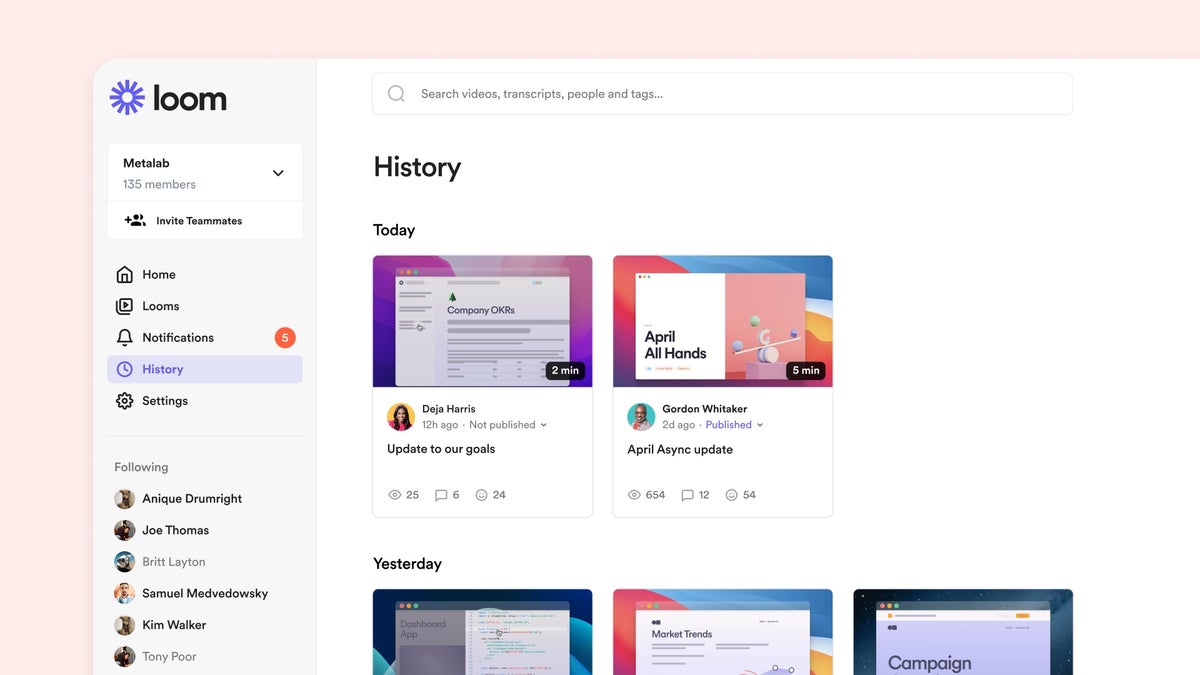
Video meetings proved vital in connecting workers during the pandemic, but video calls have drawbacks, too, with many workers complaining of hours spent in front of the camera for a seemingly endless stream of meetings.
As a result, aynchronous video has emerged as an alternative to real-time conversations that require both parties be present at the same time. And startup Loom has been one of the leaders in the market with its app, which lets users create short videos – or looms – that can be sent to colleagues and viewed whenever is convenient for them. (Think Instagram Stories or TikTok for workplace communications.)
The app has proved successful, with the company now claiming 14 million users, though it doesn’t provide details on daily or monthly active usage rates. It’s also attracted substantial funding, with $203 million to date and a reported valuation above $1.5 billion.
The company on Wednesday unveiled a substantial update to its platform aimed at creating a more collaborative environment and making it easier to discover and access content.
The biggest change is the addition of the Loom HQ, a personalized Home screen within the browser and desktop app that surfaces recommended content for users, such as “trending” videos that have been posted publicly within an organization. It’s also possible to “follow” colleagues to see when they post new content, while new search capabilities let users find videos using hashtags, as well as tagged keywords from automated video transcripts.
“The goal is to proactively get you the content you most need to be aware of, based upon your role, who you are following, and what you do at work,” said Anique Drumright, vice president of product at Loom.
The Home screen not only offers a more efficient way to find information across a company, it also serves as a “digital watercooler” that can connect workers, said Drumright.
That could be particularly useful for those who work remotely and might miss the more casual interactions often taken for granted in an office. She cited a Loom employee who typically posts about work-related topics, but on one occasion recorded a short video offering a tour of her houseplants. Within 24 hours, 15 new looms appeared as others shared similar videos.
“Every company has an organic culture that’s actually really hard to recreate in a hybrid remote setting,” Drumright said. “I believe that asynchronous video and the Loom HQ can play a really big role in recreating those moments.”
The latest updates see Loom “maturing into a fully-fledged collaboration application for teams,” said Angela Ashenden, principal analyst at CCS Insight. “It’s a big upgrade for the tool, and one which signposts the company’s ambitions in the enterprise collaboration space, putting to use some of the $130 million in funding they raised last year.
“As we head into an era of hybrid work, the need for asynchronous collaboration becomes all the more important, balancing the real-time interaction of in-person and video meetings to allow employees to collaborate effectively without necessarily needing to be working on the same thing at the same time as their colleagues.”
While Loom wants users to spend more time in its app, it remains committed to integrating with customers’ existing tech stacks, said Drumright; users can continue to send and access videos in other platforms, such as in Slack channels for example. This has been a priority for Loom, which created an SDK last year that lets vendors such as work management app Trello embed the async video capability into their own software.
Among the other updates announced this week are an improved notifications page that makes it easier to see comments and responses to videos without needing to return to the individual video. Also in development is the ability to automatically upload content from videoconferencing app Zoom, with support for other platforms in the works, Drumright said.
Although Loom is one of the early movers, it’s far from the only asynchronous video tool on the market. In addition to other startups with a similar bent, the likes of Slack, Dropbox, Zoom, and Cisco have all developed async video capabilities in the past couple of years.
The latest Loom updates help bolster the company’s position as others move into the space, said Raúl Castañón, senior analyst at 451 Research, a division of S&P Global Market Intelligence.
“While there is an overlap, the product updates it recently announced show that Loom continues to be a tool that stands on its own,” he said. “The updates build on and expand on the use cases that differentiate Loom from other vendors offering async video capabilities.
“Specifically, video management and the new Home screen together provide a content management layer; these capabilities will become critical, as user-generated video content continues to grow,” Castañón said.
[“source=computerworld”]



